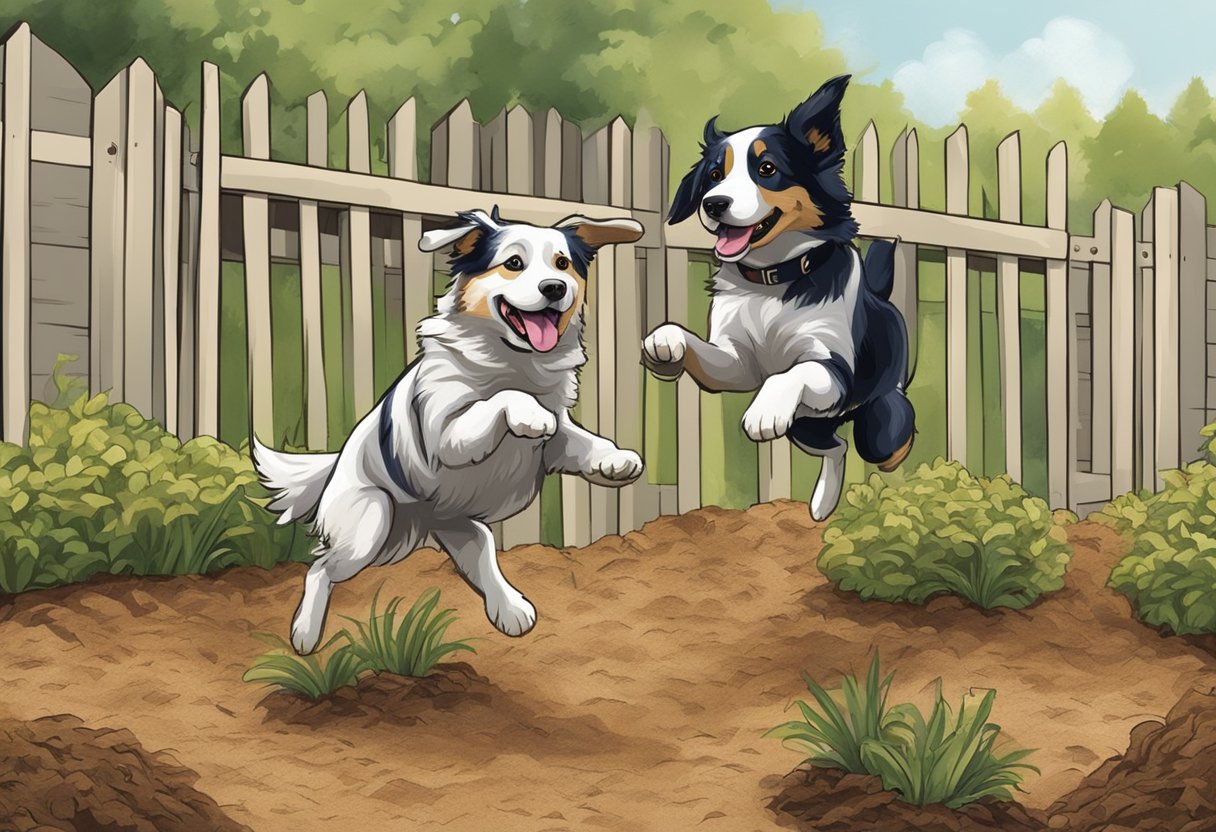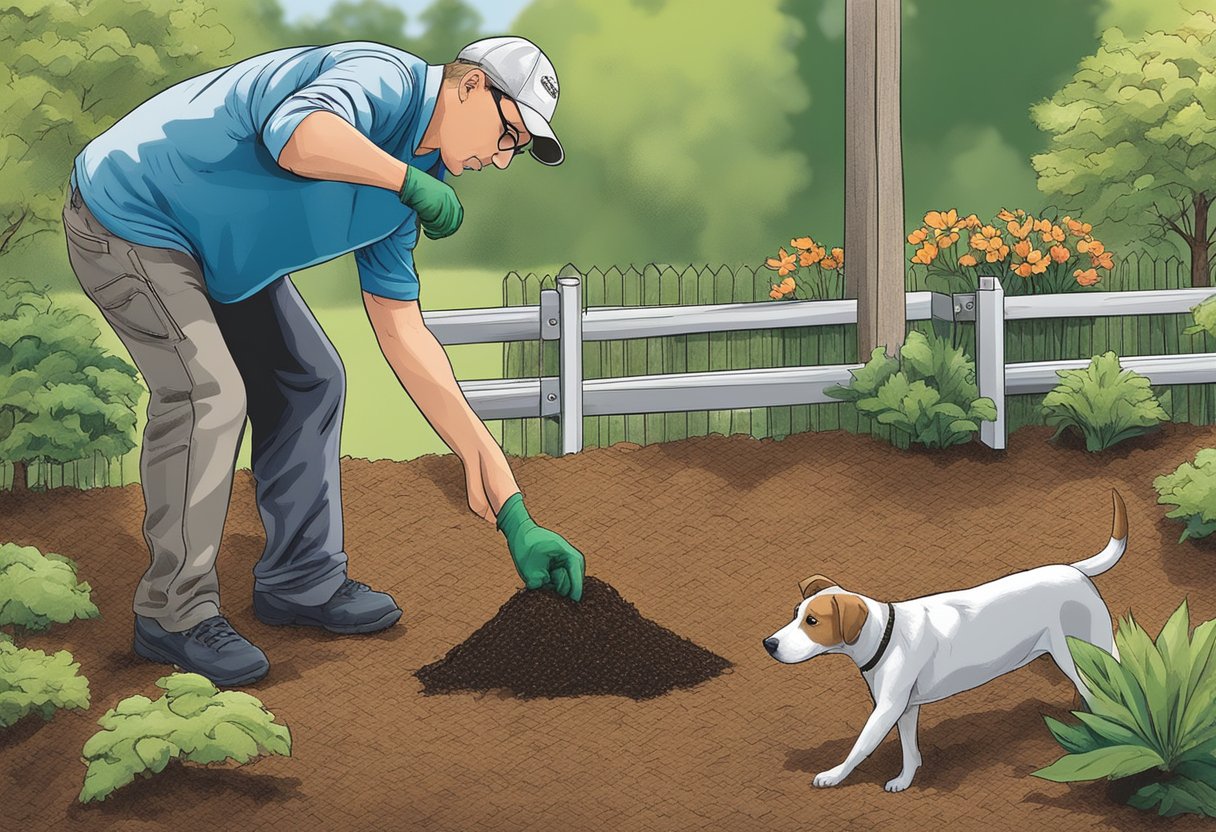Maintaining the beauty and integrity of our gardens requires some smart strategies, especially when it comes to pets.
We often find our canine companions are naturally drawn to the soft, intriguing texture of mulch. While this can lead to unwanted digging and scattering, there are effective ways to deter this behavior.
Understanding our dogs’ powerful sense of smell is key to keeping them out of garden areas they should avoid.

In our own gardens, we’ve discovered that certain scents, like citrus and citronella, are particularly off-putting to dogs.
By incorporating these smells into the garden through natural repellents, we create an invisible barrier that is non-harmful yet effective.
It’s not only about keeping the mulch intact but also ensuring the safety of our furry friends from the potential hazards mulch can pose if ingested.
Employing a variety of methods—ranging from scent deterrents to physical barriers—can ensure that our gardens and our pets coexist harmoniously.
The application of homemade sprays, thoughtful garden design, and the use of dog-repellent plants are all measures we can take.
These approaches not only protect our gardening efforts but also respect the well-being of our beloved dogs.
Preventive Strategies and Dog-Safe Mulch Alternatives
Keeping dogs out of mulch requires a combination of physical deterrents, selecting pet-friendly mulch options, applying repellents, and training.
We’ll explore diverse tactics to maintain a safe and attractive garden, alongside identifying mulch types to avoid for the health of our furry friends.

Physical Barriers to Protect Your Mulch
Fences and chicken wire are effective in keeping dogs out of mulched areas.
Consider installing a fence around your flower beds or laying chicken wire just beneath the mulch surface.
You can also use stones or pathways to create a natural barrier that discourages dogs from entering mulched zones.
Choosing Dog-Safe Mulch Types
Opt for mulches known to be safer for dogs, such as cedar mulch, which also repels pests, or pine needle mulch.
Steer clear of cocoa mulch due to its theobromine content, which can be toxic to dogs.
Homemade and Commercial Dog Repellents
A mixture of cayenne pepper, citrus, vinegar, or eucalyptus can act as a homemade repellent. However, use these with caution and ensure they are diluted to prevent harm to your pet.
Commercial dog repellents may also be considered but check for safety and efficacy.
Training Your Dog to Stay Away from Mulched Areas
Implement dog training strategies using positive reinforcement to teach your dog to avoid mulched areas.
Regular training sessions can significantly reduce unwanted digging behavior.
Creating Distractions to Discourage Digging
Provide plenty of toys and distraction to combat your dog’s boredom.
Active engagement and play can reduce their temptation to dig in your garden.
Alternative Gardening Methods Without Mulch
Consider using compost, straw, or grass clippings as alternative gardening materials that might be less attractive to dogs and still beneficial for your plants.
Mulching Techniques to Reduce Dog Intrusion
Use mulching methods such as evenly distributed shredded bark or shredded leaves, which can be less enticing for dogs to disrupt.
These methods can also enrich the soil with nutrients and maintain soil moisture.
Maintaining a Healthy Garden Ecosystem for Pets
Aim for a garden that supports both plant and pet health, balancing soil health and using gardening tips that prioritize non-toxic practices.
Identifying Potentially Dangerous Mulch Types
Be aware that cocoa bean mulch contains theobromine, which is dangerous and can lead to an allergic reaction or worse if ingested by your dog.
Always read labels and understand the components of garden mulch.
Designing a Garden That Is Both Beautiful and Dog-Friendly
Create flower beds and garden layouts that integrate dog-friendly zones away from mulched areas, using both attractive and safe designs for everyone’s enjoyment.
Recognizing Symptoms of Mulch Ingestion in Dogs
Be vigilant for signs of mulch ingestion such as vomiting, diarrhea, or obstruction.
Understanding these symptoms can lead to quick actions, including consulting a veterinarian.
Common Questions and Concerns

When it comes to the safety and aesthetics of our gardens, understanding how to protect both our dogs and our mulch is key. The following information addresses common concerns related to dogs and mulching.
Are There Any Mulches Completely Safe for Dogs?
Dog-Safe Mulch Options:
- Cypress mulch: Generally considered safer but should be untreated and monitored.
- Pine bark: A less enticing option for dogs, often safe in larger pieces.
- Cedar mulch: Natural oils may repel insects and dogs but check for additives.
Safety Note: Always ensure the mulch is free from chemical dyes and harmful by-products.
How to Address Mulch Displacement Due to Dogs
Preventative Strategies:
- Training: Regular training can discourage dogs from disturbing mulch.
- Physical Barriers: Create a border that defines the mulch area as off-limits.
Care Tip: Observe your dog to understand and address their reasons for digging or moving mulch.
Handling Health Emergencies Related to Mulch
Symptoms to Watch For:
- Anemia, vomiting, diarrhea: Immediate signs indicating potential mulch ingestion.
Action Steps:
- Contact your veterinarian or emergency pet care if symptoms occur.
- Remove all mulch that could be causing these health issues.
Assessing the Risk of Pica and Preventative Measures
Understanding Pica:
- Pica is a condition where dogs eat non-food items, such as mulch.
Preventative Measures:
- Provide alternative chew toys.
- Monitor your dogs closely in mulched areas.
Dealing with Moldy Mulch and Related Health Issues
Mold in Mulch:
- Health Risk: Mold in mulch can be a serious issue, causing respiratory problems.
Preventative Actions:
- Regularly inspect mulch for mold and replace if necessary.
- Consider mulches like pine straw or shredded bark that may resist mold better.
Frequently Asked Questions About Mulch and Dogs
Inquiries and Explanations:
| Question | Explanation |
|---|---|
| What mulches should I avoid? | Stay away from cocoa mulch, which is toxic to dogs. |
| Can I use mulch in areas my dog frequents? | Yes, but choose dog-safe mulch and apply training to prevent digging. |
| How can I keep my dog from eating mulch? | Provide supervision and distractions like toys or a dedicated digging spot. |
Expert Tip: Regularly refresh your knowledge on pet-safe gardening practices.